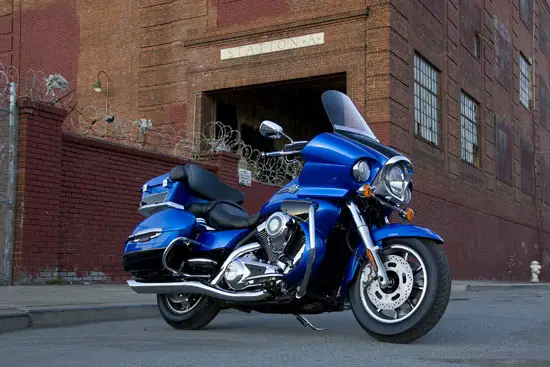
You are here: Home — 2009 Models — 2009 Kawasaki Motorcycle Models
2009 Kawasaki Vulcan 1700 Voyager
Back to 2009 Kawasaki Motorcycle Index Page
Click photos to enlarge.
They make great desktop images.

2009 Kawasaki Vulcan 1700 Voyager
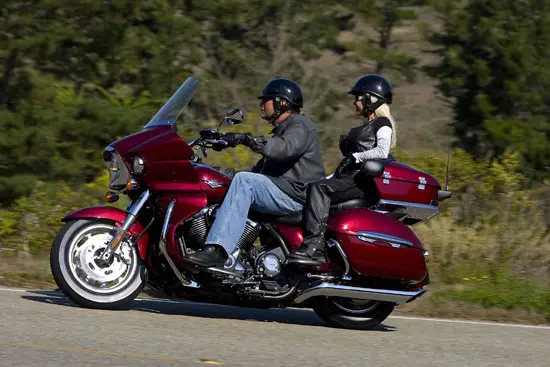
2009 Kawasaki Vulcan 1700 Voyager
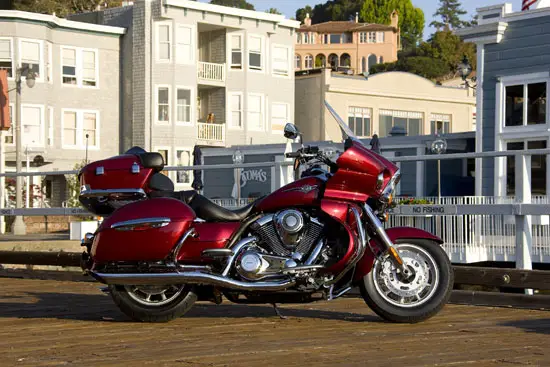
2009 Kawasaki Vulcan 1700 Voyager
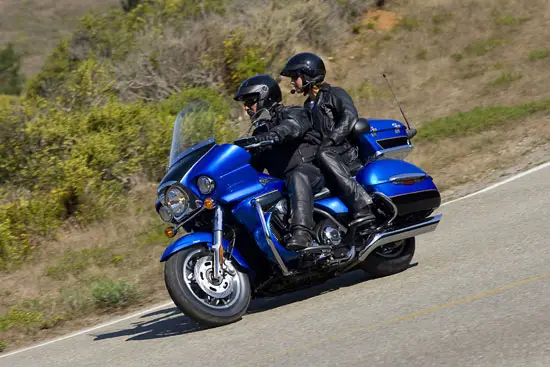
2009 Kawasaki Vulcan 1700 Voyager
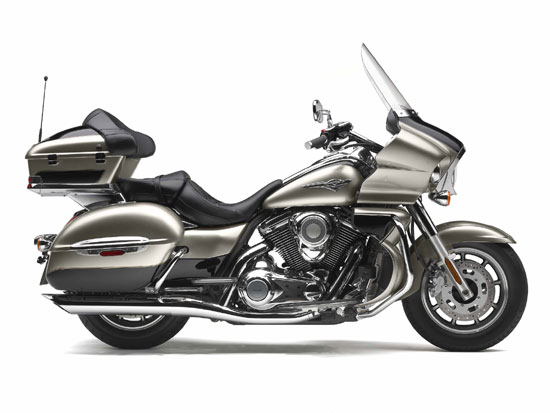
2009 Kawasaki Vulcan 1700 Voyager
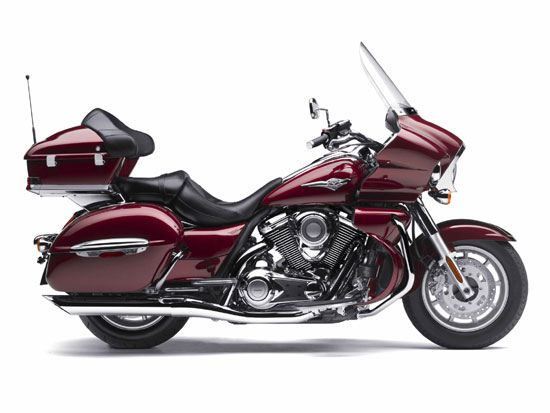
2009 Kawasaki Vulcan 1700 Voyager
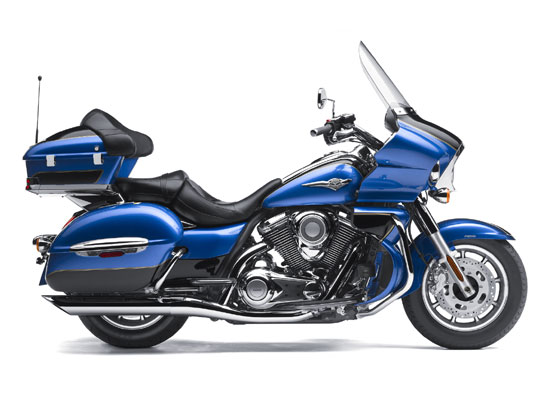
2009 Kawasaki Vulcan 1700 Voyager
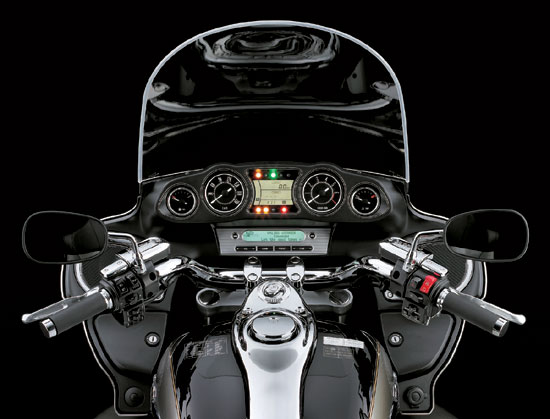
2009 Kawasaki Vulcan 1700 Voyager
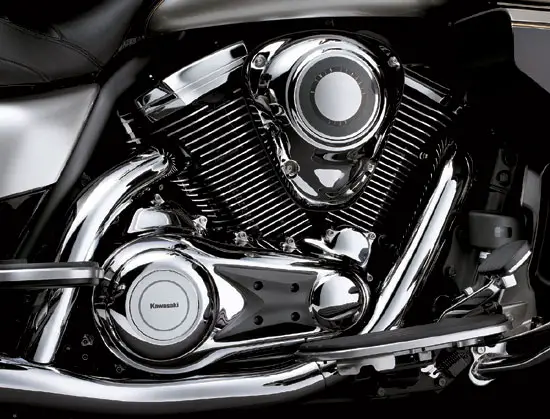
2009 Kawasaki Vulcan 1700 Voyager
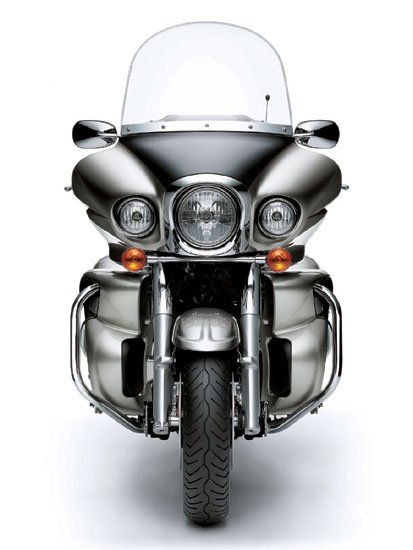
2009 Kawasaki Vulcan 1700 Voyager
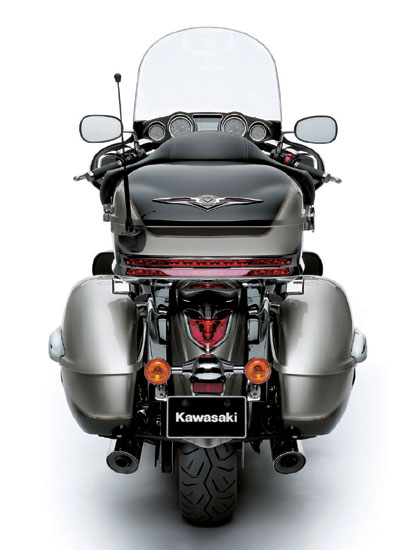
2009 Kawasaki Vulcan 1700 Voyager
– 2009 Kawasaki Vulcan 1700 Voyager
2009 Kawasaki Vulcan 1700 Voyager
Full-dress Vtwin flagship with looks and performance!
Designed for riders who set their sights beyond the horizon, Kawasaki’s new Vulcan® 1700 Voyager® offers everything needed for comfortable long-distance touring with or without a passenger. Kawasaki’s first full-dress V-Twin touring motorcycle, the new Voyager features a large frame-mounted front fairing and windshield, ample storage, a new 1700cc, long-stroke, liquid-cooled, V-Twin engine and a compact, lightweight frame.
The flagship Voyager is also loaded with the latest technology. Its standard equipment includes Kawasaki’s first fully Electronic Throttle Valve system (ETV), Kawasaki Advanced Coactive Braking Technology (K-ACT), cruise control and multi-function instrumentation with an audio system that’s compatible with iPod®, MP3 players and other systems.
The cruiser’s cutting-edge technology is headlined by Kawasaki’s sophisticated new Kawasaki Advanced Coactive Braking Technology (K-ACT) enabling riders to execute controlled, balanced braking. Available on the ABS equipped Voyager, the new system is designed to complement the rider’s braking inputs, and utilizes control valves to distribute the ideal amount of brake force for maximum stopping performance.
With input from pressure and speed sensors, the brake ECU sends directions to the motor-driven hydraulic pumps so they deliver the proper amount of pressure to the brake calipers. This speed sensitive system provides a progressive engagement and disengagement that delivers a natural feel to the rider. With the anti-lock braking (ABS) function incorporated into the K-ACT, the wheels are prevented from locking up, even under strenuous braking.
For maximum control in tight corners and when executing parking lot maneuvers, K-ACT’s coactive function does not engage when braking is initiated at speeds below 12mph and the ABS function is automatically disengaged at speeds below 4mph. Two robust 300mm front disc brakes with four-piston calipers and a single rear disc brake with a two-piston caliper provide the stopping muscle.
More unique technology is found in Kawasaki’s new fully electronic throttle valve system which makes its debut on the all-new Voyager. Working with the rest of the fuel injection system, the electronic throttle valve offers a smooth, natural engine response. It also helps the ECU to deliver an ultra-precise metering of both fuel and intake airflow to the engine and helps provide accurate cold-engine idle speed control, reduced rider fatigue and a “natural” throttle feel.
The system utilizes dual sensors; an Accelerator Position Sensor (APS) on the throttle body and a Throttle Position Sensor (TPS) on the throttle. Both of these sensors feed data to the ECU, which in turn adjusts the throttle plates with exacting precision. The system is capable of functioning on one set of data alone, offering redundancy in the unlikely event of a sensor failure.
The Voyager’s light, compact frame holds a newly designed 1700cc V-twin engine based on that of the Vulcan 2000. However, it uses a single overhead cam in each cylinder head, rather than push-rod actuated OHV arrangement. This permits higher revs and quick acceleration from the new engine – delivering superior passing performance at highway speeds. The new engine’s compression and displacement increase, and long-stroke design delivers significant torque and power gains over its predecessor.
This is no V-twin from yesteryear. The Voyager’s fuel injection system, like those in use on Kawasaki’s Ninja® 650R and Vulcan 900 motorcycles, utilizes one sensor in place of the usual three for less complexity and weight. Besides the obvious advantages of FI like improved fuel economy, the system also permits easy hands-off warm-up and idle control.
The Voyager’s FI and exhaust are tuned to deliver its peak torque and horsepower at higher rpm – ideal for its open road operating environment. More touring refinement comes from the clutch, which features six damping springs and progressive three-stage damping for smoother torque delivery and easier shifting from the big 1700cc engine under hard acceleration.
Kawasaki’s latest innovative technology is matched with essential touring features like cruise control and a six-speed transmission with overdrive fifth and sixth gears. The cruise control is conveniently operated from the right side of the handlebar and can be activated between 30 and 85 mph in third gear or above. Disengagement is easily accomplished by using the brake lever, clutch lever, rear brake pedal or closing the throttle.
The new six-speed transmission features overdrive and a super strong carbon fiber drive belt. The tall fifth and sixth gears contribute to relaxed riding and better fuel economy at highway speeds. The new carbon fiber drive belt has a 40-percent higher tensile strength than current Kevlar units, and allows it to use a thin and light 28mm belt that helps keep the width of the Voyager to a minimum.
The Voyager supplies superior protection from the wind and the elements thanks to a large frame-mounted windshield and front fairing, as well as leg shields. Mounting the fairing to the frame transfers any wind buffeting to the bike rather than the handlebars, reducing rider fatigue on long trips. Airflow to the lower extremities can be adjusted via air vents in the leg shields.
Nothing needs to be left behind thanks to the color-matched, top-mounted 13.2 gal (50L) lockable trunk – large enough to fit two large full-face helmets – and the sealed and lockable, top-opening saddlebags offer another 8.6 gal (38L) of volume each. Besides this ample storage, the Voyager also has lockable glove boxes up front providing a handy place for storing small items and accessories. An iPod player jack (optional iPod accessory connector required) is located in the left-side glove box.
Comfortable seating for the rider and passenger is a must on a touring bike and the Voyager delivers again with plush deluxe seats that are sculpted for all-day comfort. Contributing to long-distance passenger comfort is a luxury backrest with integrated passenger grab bars and floorboards for both the rider and passenger.
Advancing the riding comforts to the next level are the instruments and built-in radio on the Voyager’s classic automotive style console. The image is reinforced by the classic font used on the large round dials of the instrumentation and the radio that’s reminiscent of 8-track players from the 1960s.
Mixed in with the retro analog dials is a multi-function LCD display in the center of the instrument console. It’s controlled by switches on the right handle and features a gear position indicator, clock, odometer, dual trip meters, remaining range and average fuel consumption.
The intercom headset-compatible, 40W, twin-speaker audio system features a three-band (FM/AM/WX) radio that is also compatible with an iPod, a XM radio tuner or a CB radio unit. The audio system (and iPod) can be operated by an integrated controller on the left handlebar. Besides volume, the rider can adjust the bass, treble and balance levels of the system.
The Voyager also features a water-cooled alternator with rare-earth magnets that produces an impressive 48.5 amps of electrical output; enough to power add-on navigation systems and other electrical accessories that enrich modern touring. The Voyager has a convenient cigarette lighter-style power port on the dash and two power outlets under the seat – ideal for plugging in electrically heated vests.
The designers were able to infuse the abundant technology into the new Vulcan 1700 Voyager with the presence and visual appeal expected of a Kawasaki flagship. Like the dashboard, the Voyager’s bodywork continues the 60’s muscle car inspiration with its study of muscular curvature. The meticulous attention to detail and exquisite craftsmanship expended on both bodywork and engine covers is revealed in the contoured forms that look good from any angle and are as pleasing to the touch as they are to the eye.
Designed from the start to be as light and slim as possible, the new single backbone double cradle frame uses the minimal amount of forged parts and metal for a reduction of 4.4 pounds and a 40-percent increase in rigidity. With a shorter seat to steering head distance, the new lightweight chassis is more compact and shorter overall with a corresponding decrease in wheelbase. The easy-to-reach handlebars facilitate better low-speed maneuvering and contribute to greater rider confidence and comfort.
Adding to the light and easy handling of the new chassis design are the new suspension components, which are tuned to match the Vulcan 1700 Voyager’s touring performance. Dual adjustable rear air-shocks provide 3.1 inches of travel, and include air adjustable spring preload and rebound adjustment to ensure a comfortable ride feel with unique settings for the Voyager. Up front, a large 45mm fork offers four-way preload adjustment, 5.5 inches of travel and promotes precise steering feedback.
The Voyager rolls on new nine-spoke cast wheels, which use tubeless tires and complement its new muscular styling. Mounted on the attractive wheels are a 130/90 front radial tire and a wide, 170/70 rear radial tire. These aren’t the giant size tires that can “dull” handling, but beefy treads that offer good traction, smooth ride and good style.
Offering a stylish alternative to traditional V-Twin tourers, the new Vulcan 1700 Voyager combines Kawasaki reliability with the performance, comfort and amenities that long-distance touring riders demand.
Authentic Kawasaki Accessories are available through Kawasaki dealers.
Features
Powerful 1700cc V-Twin engine
– Liquid cooled, 4-valve per cylinder, fuel-injected 1700cc V-twin engine
– Long-stroke 102 x 104mm bore and stroke helps deliver high levels of torque – approximately 15 percent greater than that of the Vulcan 1600
– Valve system is based on the Vulcan 2000, but uses a SOHC arrangement instead of OHV for more direct engine feel and quicker revving
– Semi-dry sump allows a lower crankshaft placement and a longer piston stroke without increasing engine height
– Single-pin crank provides the desirable power-pulse feel
– Twin counter-balancers handle smoothing the engine pulses
– A large capacity airbox is located on both sides of the engine
– Small-diameter iridium sparkplugs reach deep into the combustion chamber for high combustion efficiency, especially at low-load operation (near idling)
– Features dual mufflers, one on each side of the bike
– Engine tuning offers superior acceleration in the 50-70mph (80-113km/h) range
– Even in overdrive, the engine pulls strongly in this speed range, facilitating overtaking at highway speeds
Next Generation FI
– Based on systems already on Ninja 650R and Vulcan 900
– Utilizes one sensor in place of the usual three, for less complexity and weight
– The touring-oriented Voyager utilizes a FI and exhaust set up to deliver its torque and horsepower peak at a higher rpm
Electronic Throttle Valve System
– Kawasaki’s first fully electronic throttle actuation system enables the ECU to control the volume of intake air (via throttle valves) and fuel (via fuel injectors) delivered to the engine. Ideal fuel injection and throttle valve position results in smooth, natural engine response
– Control of both fuel injection and airflow enables precise cold-engine idling speed control
– From the rider’s perspective, the ETV works like a standard cable-operated throttle – the throttle grip is still connected to cables, so the feel at the grip is the same
– Twisting the throttle turns a throttle pulley on the throttle body actuating the Accelerator Position Sensor (APS), located on the throttle body, to send a signal to the ECU, which then actuates the throttle valves via a DC motor. Throttle position is confirmed to the ECU by Throttle Position Sensor (TPS)
– APS and TPS send two sets of signals to the ECU for system redundancy in the unlikely event of a sensor failure.
Cruise control
– Operation of the cruise control is conveniently from the right handle
– Cruise control can be activated between 30mph (47km/h) and 85mph (137km/h) in 3rd gear or above
– Operating the brake lever, clutch lever or rear brake pedal disengages the cruise control as will closing the throttle beyond the “zero-throttle” position
On Board Diagnostics
– Diagnostic system allows self testing of the electronic systems on the Vulcan 1700
– Displays codes on the instrumentation, which can be read by owner; using accessory manual
Transmission / Final Drive
– Six-speed transmission
– 6th gear is an overdrive gear, contributing to stress-free riding and better fuel economy when cruising at highway speeds
– The clutch features six damping springs for three-stage progressive damping that contributes to smoother feeling under hard acceleration
– 28mm carbon fiber final drive belt has a 40 percent higher tensile strength than current Kevlar units nearly twice its width and allows the Vulcan 1700 to use a slim belt only 2mm wider than that on the Vulcan 900
– The drive belt is quiet and efficient and helps reduce maintenance chores
Kawasaki Advanced Coactive-Braking Technology (K-ACT)
– Available on ABS models, Kawasaki’s sophisticated new K-ACT enables riders to execute controlled, balanced braking in all situations. Designed to complement the riders’ applied brake control, the system distributes the ideal amount of brake force to maximize braking efficiency
– Rider actuation of the front brake lever and/or rear brake pedal causes brake fluid to act directly on caliper pistons per usual brake systems. Pressure sensors at each brake master cylinder, front and rear detect the amount of braking force the rider is applying while the ECU measures the vehicle speed at time of initial brake application via the vehicle speed sensors at the front and rear wheels
– After determining the amount of corresponding brake force needed for maximum braking efficiency, motor driven fluid pumps in front and rear pressure control units, increase pressure to the front right caliper and/or rear caliper as necessary
– Two more pressure sensors (one measuring front right caliper fluid pressure, the other measuring rear caliper fluid pressure) provide feedback to the brake ECU
– K-ACT also incorporates anti-lock braking (ABS) function so the wheels do not lock up
– For maximum controllability in tight corners and when executing U-turns, K-ACT’s coactive function does not engage when braking is initiated at speeds below 12mph and the ABS function is disengaged at speeds below 4mph
– Both ABS and non-ABS models utilizes dual 300mm front disc brakes with four-piston calipers and a dual-piston rear disc brake for smooth, powerful stops
Light handling chassis
– A more compact package than its predecessors, the new frame features a shorter wheelbase, and shorter distance between the seat and frame head pipe, for improved rider ergonomics and easier maneuverability
– Designed to be as light and slim as possible, the frame minimizes the number of forged parts and trims any unnecessary metal. The only forged parts are areas that require additional strength – the down-tube joint, engine brackets, side-stand bracket, and rear fender/shock absorber bracket
– The new frame is 4.4 pounds lighter than its predecessors, and has a 40% increase in rigidity
– The compact design contributes to light handling and facilitates handling at low speeds, especially when executing precise slow speed maneuvers like parking or making U-turns
45mm Telescopic Fork
– Provides superb steering feedback and excellent ride quality
– Features 4-way preload adjustment
Dual Adjustable Rear Air-Shocks
– Feature Air adjustable spring preload to match the load
– 4-way rebound damping for a smooth and comfortable ride
– Settings are specific to the touring needs of the Voyager
9-Spoke Cast Wheels
– Allows the use of tubeless tire and complement its new muscular styling
– 130/90 front and 170/70 rear radial tires offer good traction, smooth ride and classy style
– Tire choice and suspension settings augment the light handling characteristics
V-twin Visual Appeal
– Basic engine structure has a great impact on a V-Twin engine’s appearance.
– The line created by the top of the airbox and the cylinder heads forms a curved lined that continues to flow through the bike.
– Deeply chromed engine covers have curved upper surfaces. Their three-dimensional form adds volume and gives a quality appearance.
– The edges of the fins receive a special NC treatment that makes them gleam in sunlight
– All the non-chromed parts of the engine have a matt black finish that further accentuates the chromed parts
Bodywork
– Muscular front fairing is reminiscent of classic American muscle cars in its sculpted, flowing design.
– Chromed headlamp cover and twin fog lights contribute to the muscle car theme
– The fuel tank’s hand-sculpted contours employ constantly varying radii, giving the bike a dynamism that is pleasing both to the eye and to the touch
– Its lines flowing through the rest of the bike, the elegantly shaped fuel tank contributes to the Voyager’s curvaceous figure
– Liberal use of chrome contrasts nicely with the bodywork’s deep, lustrous paint. The engine, front and rear guards, accents on the panniers and trunk and the trunk brackets are fully chromed
– Motif from the front fender continues on the rear fender, which features an elegant LED taillight
– Front and rear guards help protect the bike’s bodywork in case of a fall
– Dual 35W fog lights have a dedicated On/Off switch and can be adjusted vertically
– In addition to the taillight on the rear fender, the Voyager also has a large, highly visible LED taillight mounted on the rear of the trunk that contributes to its appearance
Classic Retro Dashboard
– Instrument layout and large round dials give the Voyager’s console a classic automotive elegance, that is reinforced by the font used on the instrumentation
– Even the radio has a classic look, reminiscent of the 1960s
– Multi-function LCD display in the center of the instrument console is controlled by switches on the right handle. Features include a gear position indicator, fuel gauge, clock, odometer, dual trip meters, remaining range and average fuel consumption
– Analog displays include speedometer, tachometer and coolant temperature gauge
– Audio system with twin speakers features radio (FM/AM/WX) and compatibility with an iPod, XM tuner or CB radio unit
– The audio system (and iPod) can be operated by switches on the left handlebar
– Ignition switch allows on-position key removal; preventing key bunches from damaging the luxurious chrome finish around the ignition area while the bike is in operation
– Turning the ignition switch collar to the ACC” position allows accessories to be used while the engine is off and turning it to the “OFF” position turns the engine off and necessitates re-insertion of the key to restart
– A number of features facilitate long-distance touring and rider and passenger comfort
Wind protection
– Large windshield and front cowling protect rider and passenger from wind and elements
– With the front cowling mounted to the frame, any wind buffeting is transferred to the bike rather than the handlebars, contributing to reduced rider fatigue on long trips
– Leg shields have air vents that allow airflow to the legs to be adjusted
Ample storage
– 13.2 Gal (50L) lockable trunk is large enough to fit two full-face helmets
– Top-opening panniers are also sealed and lockable, with a volume of 8.6 gal (38L) each
– Up front, lockable glove boxes provide a handy place for storing small items and accessories. An iPod jack (optional connector required) is located in the left-side glove boxComfort
– Sculpted seat designed for both comfort and easy reach to the ground
– Upright riding position and floorboard contribute to all-day touring comfort
– Roomy passenger seat is complemented by padding on the trunk that provides back and arm support
– Rear floorboards contribute to passenger comfort
– Dual adjustable rear air-shocks ensure a comfortable ride feel
Long range
– 5.3 gallon fuel tank offers a substantial range, helping to minimize fuel stops when out on the open road
2009 Kawasaki Vulcan 1700 Voyager – USA Specifications
MSRP: $TBD USD
Engine: Four-stroke, liquid-cooled, SOHC, four valves per cylinder, V-twin
Displacement: 1,700cc / 103.7ci
Bore x Stroke: 102 x 104mm
Compression Ratio: 9.5:1
Maximum Torque: 107.8 lb-ft @ 2,750 rpm
Cooling: Liquid, plus cooling fins
Induction: Digital fuel injection, dual 42mm throttle bodies
Ignition: TCBI with Digital Advance
Transmission: Six-speed with overdrive
Final drive: Belt
Frame: Steel, double-cradle with box-section single-tube backbone
Rake / Trail: 30° / 7.0 in.
Suspension, Front / Wheel Travel: 43mm hydraulic fork / 5.5 in.
Suspension, Rear / Wheel Travel: Swingarm with twin air-assisted shocks, with 4-way rebound damping / 3.1 in.
Front Tire: 130/90×16
Rear Tire: 170/70×16
Brakes, Front Dual 300 mm discs, dual twin-piston calipers
Brakes, Rear: Single 300 mm disc, twin-piston caliper
Overall Length: TBD in.
Overall Width: TBD in.
Overall Height: TBD in.
Ground Clearance: TBD in.
Seat Height: TBD in.
Wheelbase: TBD in.
Curb Weight: TBD lbs.
Fuel Capacity: 5.3 gal.
Colors: Candy Diamond Red
Two-tone: Candy Plasma Blue / Metallic Diablo Black
Two-tone: Metallic Titanium / Metallic Diablo Black
MSRP Standard / ABS:
Standard Two-tone / ABS: TBD
Warranty: 36 Months
2009 Kawasaki Vulcan 1700 Voyager – Canada Specifications
MSRP $TBA CDN
Type Liquid-cooled, 4-stroke V-Twin
Displacement 1,700 cm3
Bore and Stroke 102 x 104 mm
Compression ratio 9.5:1
Valve system SOHC, 8 valves
Fuel system Fuel injection:f42 mm x 2
Ignition Digital
Starting Electric
Lubrication Forced lubrication, semi-dry sump
DrivetrainTransmission 6-speed, return
Final drive Belt
Primary reduction ratio 1.515 (50/33)
Gear ratios: 1st 3.077 (40/13)
2nd 1.900 (38/20)
3rd 1.407 (38/27)
4th 1.143 (32/28)
5th 0.967 (29/30)
6th 0.806 (29/36)
Final reduction ratio 2.250 (72/32)
Clutch Wet multi-disc, manual
FrameType Double-cradle, steel
Wheel travel: front 140 mm
Wheel travel: rear 80 mm
Tyre: front 130/90B16M/C 67H
Tyre: rear 170/70B16M/C 75H
Caster (rake) 30º
Trail 177 mm
Steering angle (left/right) 35º / 35º
SuspensionFront: type 45 mm telescopic fork
Rear: type Swingarm with twin air-assisted shocks
Rear: rebound damping 4-way
BrakesFront: type Dual 300 mm discs
Front: caliper Dual 4-piston
Rear: type Single 300 mm disc
Rear: caliper Twin-piston
DimensionsOverall length TBA
Overall width TBA
Overall height TBA
Wheelbase TBA
Ground clearance TBA
Seat height TBA
Curb mass TBA
Fuel capacity 20 litres
PerformanceMaximum power 61 kW {82 PS} / 5,000 rpm
Maximum torque 146 N·m {14.9 kgƒ·m} / 2,750 rpm
DetailsColours Metallic Titanium, Candy Plasma Blue, Candy Diamond Red
Warranty TBA
Good Times Protection Plan 24 or 36 months (Kawasaki GTPP coverage begins after the standard limited warranty expires)
MSRP TBA
2009 Kawasaki Vulcan 1700 Voyager – UK Specifications
MSRP: £TBA
TBA
*Prices and specifications subject to change without notice.


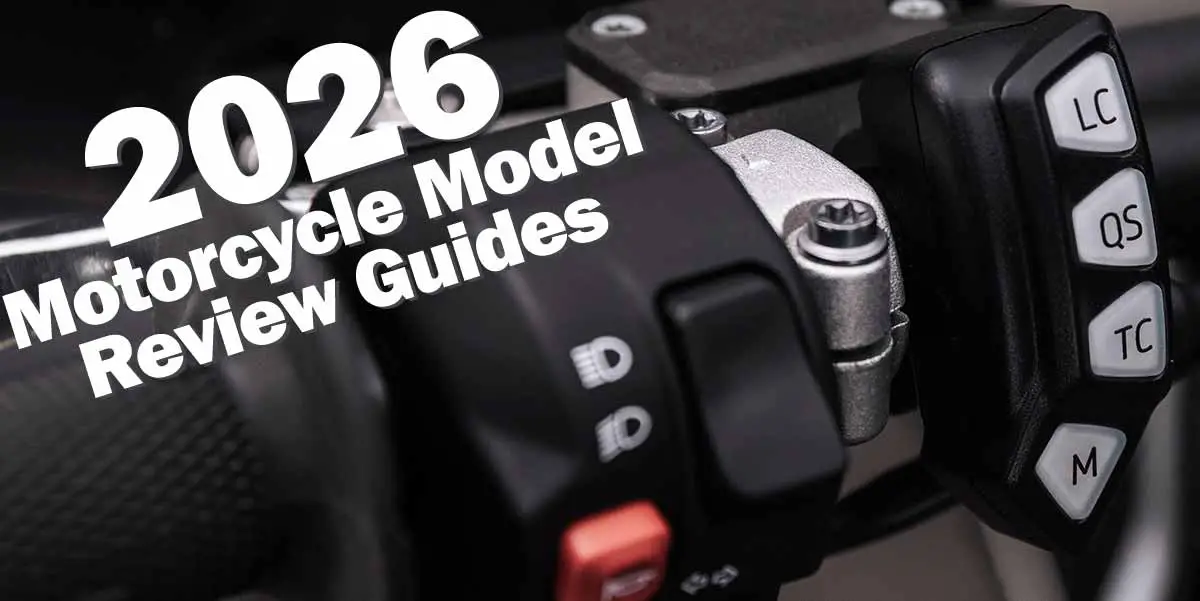
Be the first to comment